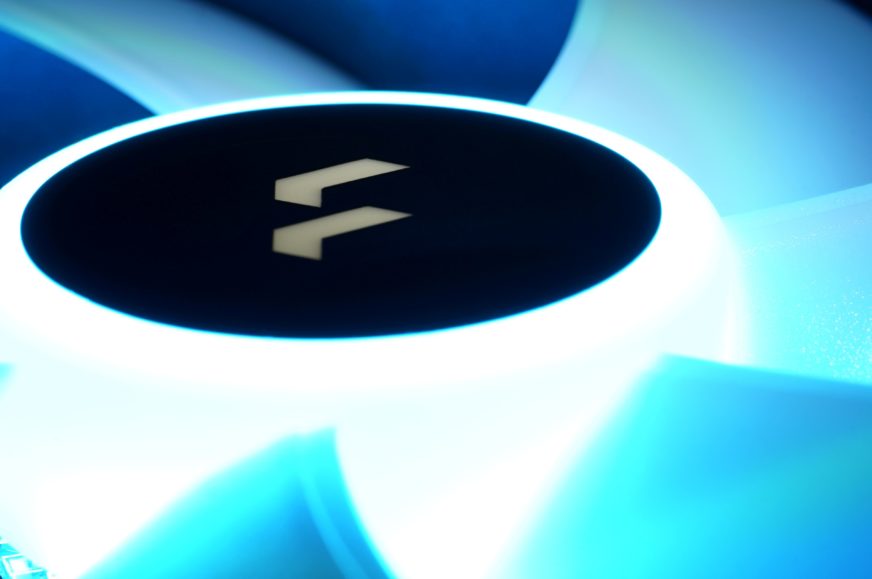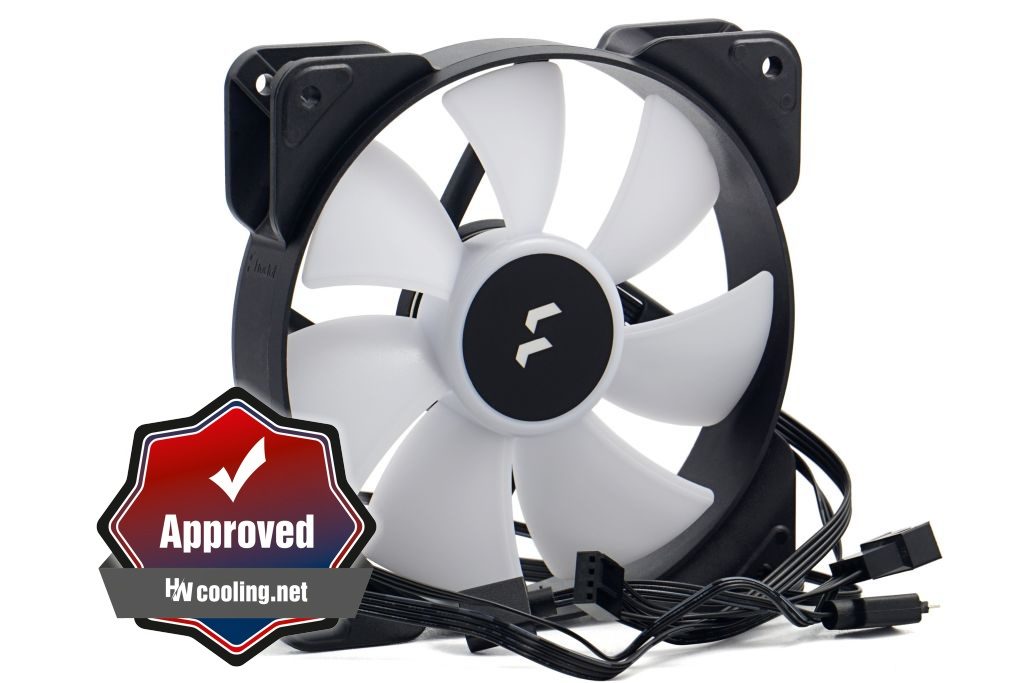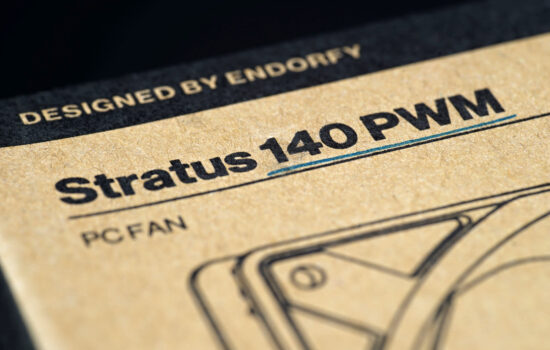Fractal Design Aspect 12 RGB PWM in detail
An old-school rotor with one small aerodynamic tweak, the shortcomings of the Dynamic series of fans removed, and the addition of ARGB LED lighting. There are negatives too, but with the right application you can neatly avoid them. Overall, though, Fractal Design’s Aspects are functionally among the most feature-rich of what’s available in the current lineup of LED fans.
Evaluation
Fractal Design has squeezed almost the maximum out of this blade shape, as seen in the high airflow across all noise levels – from the quietest modes, through medium to noisier/more intensive modes. While not enough for the very high-end for the reasons explained in the first chapter, the results that only fall just below the BeQuiet! Silent Wing 3 and above the Noctua NF-P12 redux are an excellent showing. In such company (between SW3 and NF-P12 redux) the Aspect 12 RGM PWM holds its own even with dust filters, and at very low speeds it even achieves higher efficiency.
In the quietest test mode with a plastic filter, the Fractal Design fan (with approx. 700 rpm) is at the very top of the charts. That’s thanks to the quiet motor, which slightly rattles on the Dynamic X2 fans. However, the Aspects have eliminated this sound (between 1–2 kHz) and can therefore be very quiet. You won’t slow them down to total extremes though, it’s not allowed by the relatively higher start-up/minimum speed of around 510 rpm. Compared to the Dynamic X2, these new Aspects still achieve higher airflow under optimal conditions at the same noise level. The latter may be the answer to why Fractal Design removed those cutouts on the trailing edges of the blades from the rotor on all fans after the Dynamic X2.
Surprisingly, Aspect performs rather poorly on a hexagonal grille. This is the only situation where this fan loses to the Dynamic X2. And quite significantly so. Yet the Aspects achieve higher static pressure and airflow through radiators is already seemingly higher, paradoxically (compared to the Dynamic X2). Strange, isn’t it? In practice, however, this does not work as presented by the lines “for a case”, “for a tower cooler”, “for a liquid cooler radiator” nested in the P/Q curves. This topic will soon be covered in detail in a separate article. Anyway, the Gelid Zodiac isn’t better on a grille either, and it also loses significantly more on dust filters (and can’t even be installed on unreinforced nylon).
The Aspect 12 do not have difficulties on dust filters, on the contrary, they work very effectively on them. The degradation comes only in combination with a grille. However, the designs of new cases often do not take it into account on the intake fans. Where only a filter is in front of the rotor and the fan is installed via side mounts, in rails, everything works well and we can talk about this as an optimal environment for the Aspects. In addition, the hexagonal grille significantly amplifies the “rumbling” 350 Hz in the sound similar to the Noctua NF-P12 redux, even at lower speeds that are suitable for system cooling.
Radiator cooling results are average to above average.They are average are on denser models (with higher FPI) and above average on thinner (with lower FPI). On the latter, they are very decent for this category (relatively inexpensive fans with LEDs). The cheaper alternative with ARGB LED Gelid Zodiac achieves significantly lower efficiency in such an environment. The Aspect 12 fan performs well here (on radiators) in terms of acoustic presentation too. The noise level of the individual frequencies is balanced, with no annoying peaks, across the entire speed spectrum.
We did measure some vibration, but it’s nothing serious, although adding some damping at the frame level would make sense. Higher (but still not too high) vibrations are in the range of 1050–1350 rpm. At other speeds, their intensity is always lower, and downwards the vibrations disappear completely. Motor power draw is average with respect to speed, below average with respect to airflow. The price-to-airflow ratio is again average and finally something above average – illumination efficiency. Starting with this test we have added a graph to the measurement results that expresses the brightness intensity to power draw of RGB LEDs. The Aspect 12 RGB PWM is currently in excellent second place. Concerns about the poorer light conductivity of the white rotor (compared to the more common “clear” ones) are thus unfounded.
In summary, unless you just hang the Aspect 12 RGB PWM on a grille with sharp edges, this fan offers impressive features for the price without any major shortcomings.
English translation and edit by Jozef Dudáš
| Fractal Design Aspect 12 RGB PWM |
| + Suitable for every use |
| + Decent price/cooling performance ratio for LED fans |
| + Cooling efficiency (airflow/pressure per unit of noise) at a very high level |
| + Beats even significantly more expensive fans in performance |
| + High airflow and static pressure even through dust filters or radiators |
| + Wide speed range |
| + Virtually noiseless operation of bearings and motora |
| + Decent build quality |
| + Illumination of the rotor. And with high efficiency |
| + Long cables with two connectors for complete connection of an additional fan |
| - Higher minimum speed (~510 rpm) |
| - Does not support passive mode, does not "turn off" at low PWM intensity |
| - Mismatch with a hexagonal grille, greatly amplifies the 350 Hz frequency... |
| - ... and a significant drop in airflow |
| - Does not have anti-vibration pads |
| Approximate retail price: 16 EUR |
- Contents
- Fractal Design Aspect 12 RGB PWM in detail
- The basis of the methodology, the wind tunnel
- Mounting and vibration measurement
- Initial warm-up and speed recording
- Base 7 equal noise levels…
- .. and sound color (frequency characteristic)
- Static pressure measurement…
- … and airflow
- Everything changes with obstacles
- How we measure power draw and motor power
- Measuring the intensity (and power draw) of lighting
- Results: Speed
- Results: Airlow w/o obstacles
- Results: Airflow through a nylon filter
- Results: Airflow through a plastic filter
- Results: Airflow through a hexagonal grille
- Results: Airflow through a thinner radiator
- Results: Airflow through a thicker radiator
- Results: Static pressure w/o obstacles
- Results: Static pressure through a nylon filter
- Results: Static pressure through a plastic filter
- Results: Static pressure through a hexagonal grille
- Results: Static pressure through a thinner radiator
- Results: Static pressure through a thicker radiator
- Results: Static pressure, efficiency by orientation
- Reality vs. specifications
- Results: Frequency response of sound w/o obstacles
- Results: Frequency response of sound with a dust filter
- Results: Frequency response of sound with a hexagonal grille
- Results: Frequency response of sound with a radiator
- Results: Vibration, in total (3D vector length)
- Results: Vibration, X-axis
- Results: Vibration, Y-axis
- Results: Vibration, Z-axis
- Results: Power draw (and motor power)
- Results: Cooling performance per watt, airflow
- Results: Cooling performance per watt, static pressure
- Airflow per euro
- Static pressure per euro
- Results: Lighting – LED luminance and power draw
- Results: LED to motor power draw ratio
- Evaluation












